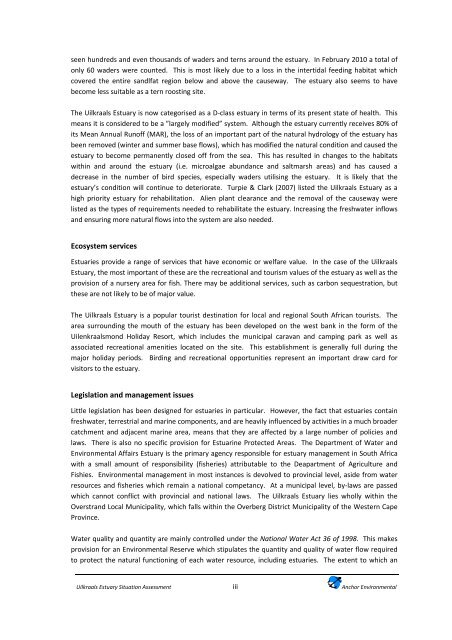Uilkraals Situation Assessment - Anchor Environmental
Uilkraals Situation Assessment - Anchor Environmental
Uilkraals Situation Assessment - Anchor Environmental
You also want an ePaper? Increase the reach of your titles
YUMPU automatically turns print PDFs into web optimized ePapers that Google loves.
seen hundreds and even thousands of waders and terns around the estuary. In February 2010 a total ofonly 60 waders were counted. This is most likely due to a loss in the intertidal feeding habitat whichcovered the entire sandlfat region below and above the causeway. The estuary also seems to havebecome less suitable as a tern roosting site.The <strong>Uilkraals</strong> Estuary is now categorised as a D‐class estuary in terms of its present state of health. Thismeans it is considered to be a ”largely modified” system. Although the estuary currently receives 80% ofits Mean Annual Runoff (MAR), the loss of an important part of the natural hydrology of the estuary hasbeen removed (winter and summer base flows), which has modified the natural condition and caused theestuary to become permanently closed off from the sea. This has resulted in changes to the habitatswithin and around the estuary (i.e. microalgae abundance and saltmarsh areas) and has caused adecrease in the number of bird species, especially waders utilising the estuary. It is likely that theestuary’s condition will continue to deteriorate. Turpie & Clark (2007) listed the <strong>Uilkraals</strong> Estuary as ahigh priority estuary for rehabilitation. Alien plant clearance and the removal of the causeway werelisted as the types of requirements needed to rehabilitate the estuary. Increasing the freshwater inflowsand ensuring more natural flows into the system are also needed.Ecosystem servicesEstuaries provide a range of services that have economic or welfare value. In the case of the <strong>Uilkraals</strong>Estuary, the most important of these are the recreational and tourism values of the estuary as well as theprovision of a nursery area for fish. There may be additional services, such as carbon sequestration, butthese are not likely to be of major value.The <strong>Uilkraals</strong> Estuary is a popular tourist destination for local and regional South African tourists. Thearea surrounding the mouth of the estuary has been developed on the west bank in the form of theUilenkraalsmond Holiday Resort, which includes the municipal caravan and camping park as well asassociated recreational amenities located on the site. This establishment is generally full during themajor holiday periods. Birding and recreational opportunities represent an important draw card forvisitors to the estuary.Legislation and management issuesLittle legislation has been designed for estuaries in particular. However, the fact that estuaries containfreshwater, terrestrial and marine components, and are heavily influenced by activities in a much broadercatchment and adjacent marine area, means that they are affected by a large number of policies andlaws. There is also no specific provision for Estuarine Protected Areas. The Department of Water and<strong>Environmental</strong> Affairs Estuary is the primary agency responsible for estuary management in South Africawith a small amount of responsibility (fisheries) attributable to the Deapartment of Agriculture andFishies. <strong>Environmental</strong> management in most instances is devolved to provincial level, aside from waterresources and fisheries which remain a national competancy. At a municipal level, by‐laws are passedwhich cannot conflict with provincial and national laws. The <strong>Uilkraals</strong> Estuary lies wholly within theOverstrand Local Municipality, which falls within the Overberg District Municipality of the Western CapeProvince.Water quality and quantity are mainly controlled under the National Water Act 36 of 1998. This makesprovision for an <strong>Environmental</strong> Reserve which stipulates the quantity and quality of water flow requiredto protect the natural functioning of each water resource, including estuaries. The extent to which an<strong>Uilkraals</strong> Estuary <strong>Situation</strong> <strong>Assessment</strong>iii<strong>Anchor</strong> <strong>Environmental</strong>
















